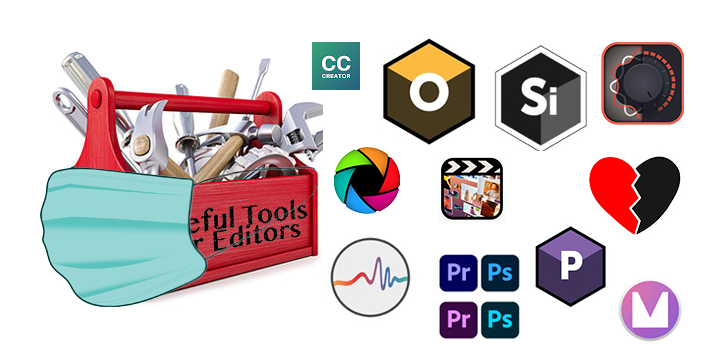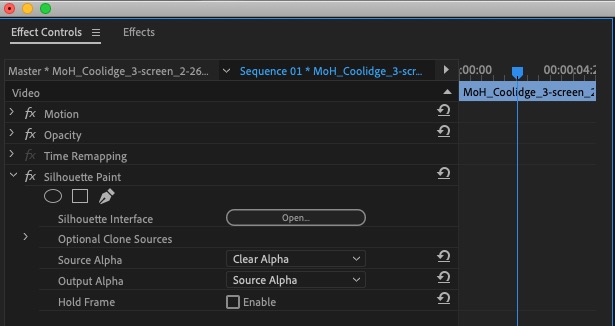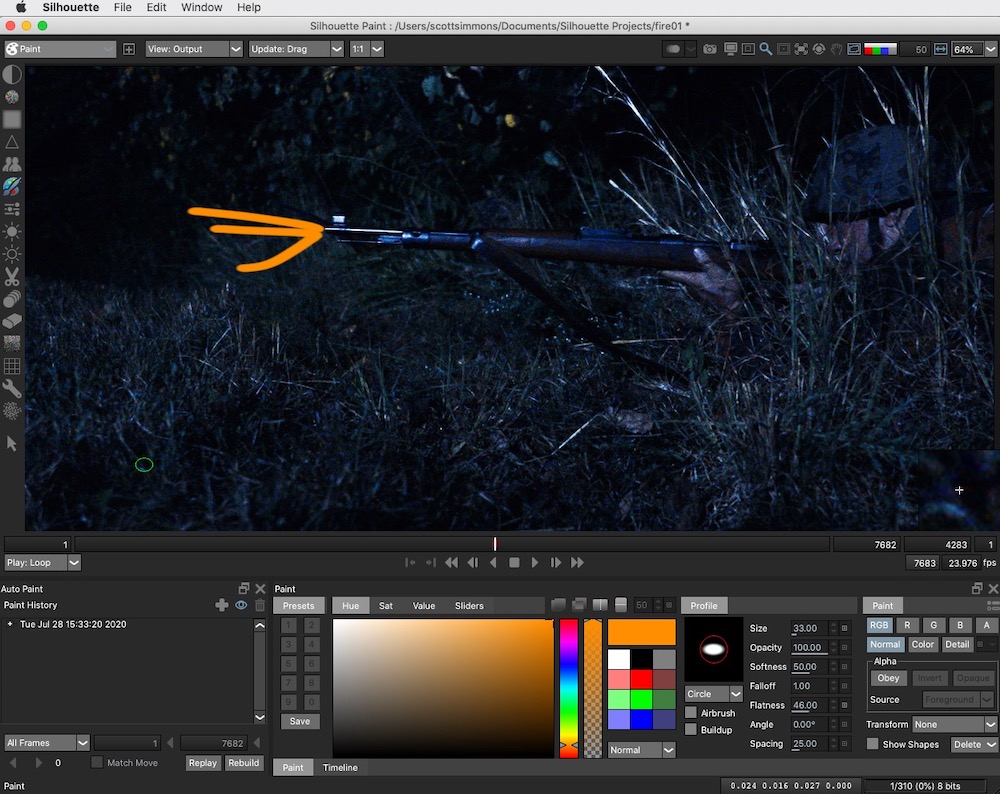
It’s hot, it’s muggy and we’re still having to be socially distant or staying at home or quarantined depending on where you are. Unless you’re in one of those parts of the world that are in the cold days of winter then you have your own unique weather patterns to deal with.
Let’s start off with Boris FX as the folks at Boris have been very busy.
Boris Silhouette Paint
![]()
- Paint Tools with pressure-sensitive customizable brushes. Includes Clone, Blemish, Grain, Repair, Drag, Dodge, Burn, and more.
- Fast & Non-Destructive Auto Paint: Highly-efficient layer system for large resolution film/video paint. Auto Paint recording system delivers the speed of a raster-based paint system with the flexibility of vector paint.
- Powerful Motion Tracking: Features multiple tracking options including integrated Mocha for rock-solid planar tracking.
- Channels & Detail Separation: Paint on individual RGBA channels or choose to work on separated detail and color views for advanced control.
- Cloning and Patching: Advanced clone offset and warping, onion skin, and display views enable a streamlined workflow for aligning patches and removing unwanted pixels.
- Detail Separation: Work on separated detail (coarse, medium,& fine) and color for advanced control.
- Color Management: Supports OpenColorIO for high-end VFX and finishing workflows.

You can apply Silhouette Paint right to a shot in your NLE timeline and then harness the powerful paint effects including Mocha planar tracking without leaving the NLE. Now you do have to launch the Silhouette Paint interface and do your paint work and that interface is another world from your NLE.

If you’re familiar with visual effects painting software you’ll feel right at home in Silhouette Paint. I’m not so you’ll probably be able to make a better muzzle flash than me. Thankfully there are a lot of video tutorials to help.
A flip of the menu in Silhouette Paint and you get full rotoscoping tools. Again, this is all without roundtripping footage in and out of your NLE. These kinds of things make me wish I was better at visual effects! Pricing ranges from $195 per year for and Adobe license to $395 per year for an OFX license that will run in Resolve and other hosts. Also, compare Silhouette vs. Silhouette Paint to get a better idea of the standalone vs the plug-in.
Boris Particle Illusion Standalone
There are a lot of fun particles to play with in Particle Illusion. You can really build some nice backgrounds and since you can export a ProRes with an alpha channel from the free version it can be useful. There is a comparison chart of the standalone version vs the paid plug-in version so you can compare. If you want to buy the full $295 version (which is a piece of Boris Continuum) you get full host compatibility in all the NLEs (Resolve and VEGAS included) as well as After Effects and NUKE.
Boris Optics
Yes there are two suns as well as lightning in the fishing picture above. Notice the layered approach to Optics on the left. Each layer can have masking to blend the effects. The different categories are listed along the bottom. Optics feels a bit like Magic Bullet Looks so the way you interact with the image is similar. It’s a lot of fun and you can really lose some time playing around with it. It’ll be a nice addition for photographers. Dig into some of the videos for more info on how to use Boris Optics.
The Levelator
The Levelator is an amazing little free utility from way back when with a singular purpose: take your AIFF or WAV file and level it out. It was designed for podcasting so it works great on voices. I’ve run interview audio through it in a pinch before and let it do it’s leveling thing before tossing it into an edit. It’s been around for years and one of the creators was an original inventor of Plural Eyes.
It’s nice to visualize the result when you’re done:
When The Levealtor is done it creates a new file with the -leveled suffix. There are not settings so what you get is what you get. Not a big deal if you don’t want to use it since it is free. Grab it on the Mac App Store but it’s also available for Windows and Linux but the download says it’s no longer being developed. A tweet from mid-June mentioned a new version so here it is in Useful Tools!
Levelmatic
When you watch the Premiere demo vs the FCPX demo you wish that Premiere would adjust the waveforms when levels change. Levelmatic, Mac only, is currently $69 (regular $99) and available via the FxFactory distribution system. I must say I can’t help but notice how similar the CrumplePop tools look to the Accusonus ERA audio tools. 🤔
Video Walls 2 for FCPX
Another potentially super useful tool for today’s Zoom/split-screen world is the new update to Video Walls from Luca Visual FX. Most editors have, at this point in history, done enough Zoom style split-screens that anything to automate the process is a good thing. Video Walls 2 is FCPX only but I have to be honest that there is no better or faster tools for creating Zoom style split-screens than FCPX.
Video Walls 2 is $49 and distributed via the FxFactory platform.
Creator’s Best Friend for Final Cut Pro X and Adobe Premiere Pro
I’m not sure about that broken heart app icon though. It should be a happy icon!
Closed Caption Creator
Of particular interest might be the automatic speech-to-text caption option, automatic translation and automatic scene detection. I don’t know if a tool like MacCaption can do all of that or not (I don’t do a lot of captioning) but considering that the Telestream products start at nearly $2,000 it’s great to see another entry into this market. I haven’t tried Closed Caption Creator so if you have please let us know how it works in the comments below. Thanks Jason for finding this one!
De-Re-Branded Icons for your Adobe applications
There was a lot of bitchin’ about Adobe’s recent update that changed the icons from a colorful menagerie to drab conformity. Okay, yea whatever but if you want to make them look more like old times how about a free batch of De-Re-Branded Icons? Thanks to Element Supply you can download the more diverse Adobe icons of old.
That’s really all I have to say about that but thanks to Element Supply for those.
Mimiq
The above image is from the Indiestor website. There are bin lock icons! A little googling around reveals a lot of discussion about using Mimiq a range of shared storage systems like a Jellyfish, TrueNAS, and QNAP. Or how about Mimiq on cloud-based shared storage like LucidLink. And of course, there’s a reddit thread talking about it too. You’ll have to contact a reseller like Bridge Digital if you’re interested.
Shutter Encoder
The thing I’m intrigued about is that it can show you the audio waveform for a file. That’s cool.
The above image is from the Shutter Encoder website. Scroll down through the settings and you’ll see this is a quite full-featured little tool. It’s a fully cross-platform tool and according to the developer is based on FFMPEG. This is one to keep an eye on.
Links from Twitter:
Replace File Explorer with this free Windows app: https://t.co/HEjaB9SHcK pic.twitter.com/5278aprzwg
— Lifehacker (@lifehacker) June 26, 2020
In addition to the new shiny Stock Audio in Premiere Pro, there are some other under the hood improvements as we continue to improve performance, like faster app launch time, especially first launch.
Read more:https://t.co/NnqsDDh6lZ
— Matt Christensen (@_mchristensen) June 16, 2020
That’s the script for The Modern Ocean. I kept it quiet for a long time because…I don’t like scripts because they are not movies and movies are not film and I just didn’t want to be embarrassed. But now I think it might be fun. It’s all good, now.
— Upstream Color (@UpstreamColor) June 17, 2020
Irish Screen Editors have compiled a downloadable pdf guide to working remotely at home for editors and assistants. You can get it here https://t.co/j0dMYujpMV @irishscreenedit @screenskillsire
— Irish Screen Editors (@irishscreenedit) May 11, 2020
19 hours of interviews with legendary editor and sound designer Walter Murch, ACE on his exceptional career (THX1138, The Godfather Trilogy, American Graffiti, The Conversation, Apocalypse Now, The English Patient): https://t.co/PWbrtAkx6p#waltermurch #StayCreative #StayAtHome pic.twitter.com/nRe6f2ASnW
— Walter Murch, ACE Archives (@wmurcharchives) May 2, 2020
A PSA for Blue Yeti Microphone users:
These are side-address microphones, so you need to speak into the side of the microphone that faces the logo.They are not intended to be spoken into from the top.
A short thread – pic.twitter.com/cVt1NonTpa
— Mars Mel (@MarsMel) May 1, 2020
Here’s that free tool I made for Fusion (#Resolve) to arrange pictures into a grid. Copy/paste it from my site if you want it.#blackmagicdesign #DavinciResolve #colorgrading #vfx #indiefilm #filmmaking #Postchat #postproduction #fusion #contentcreation #contentcreators pic.twitter.com/zRlTAisx2F
— Jamie Dickinson (@dickij10) April 15, 2020
A couple of free tools for After Effects to make a grid for the number of layers in your comp. On my blog page if you want them. pic.twitter.com/GXfXZLBOLn
— Jamie Dickinson (@dickij10) April 11, 2020
Assistant Editors Bootcamp just released their AEing for Reality TV Class – usually $300 – for FREE!https://t.co/ruBxHSM9UQ
— editR (@ronsussman) March 30, 2020
Want to use Mocha for After Effects to replace any surface? Start with a stop sign! This tutorial co-produced with School of Motion wastes zero showing you how it’s done…https://t.co/x2tNTVA13V
— Mark Christiansen (@markchristiansn) March 10, 2020
RICH PEOPLE HABITS
– Be ruthless w/ your time
– Build Multiple Income Sources
– Invest Money Long Term
– Automate Your Income
– Financial Minimalism
– Have a Structured Life
– Track Your Spending
– Prioritize Your Health
– Self Education
– Outsource Frustrations— Roberto Blake 🧢 #AWESOMESQUAD (@robertoblake) January 15, 2020

